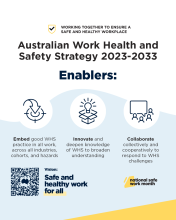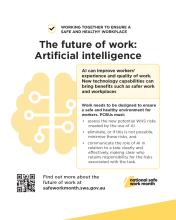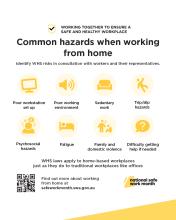Unfortunately, workers continue to be injured at work, sometimes fatally. To prevent harm we need to ensure that WHS is core to how we do our business in Australia.
This week will focus on the future of work health and safety, including changing patterns and ways of working as well as the emergence of new forms of work.
Work is constantly changing and evolving. WHS needs to keep adapting too to ensure that workers aren’t put at risk when new technologies or changes to the workforce impact the way work is performed.
The Australian Work Health and Safety Strategy (2023 – 2033)
The Australian Work Health and Safety (WHS) Strategy sets a platform for delivering WHS improvements over the next decade. The main goal of the strategy is to reduce worker fatalities, injuries and illnesses.
Increasing awareness of WHS, coordinating WHS nationally and collaboration are all important actions to get us to the goal to reduce worker fatalities, injuries and illnesses.
Putting WHS first with AI and automation
AI and automated technology can bring many benefits, including safer work and working environments. But they must be designed and deployed safely. If you’re thinking about rolling out a new innovation remember you must consult with workers and undertake a risk assessment to ensure workers are not exposed to new or existing WHS risks.
Managing WHS risks in the green economy
In response to climate change, Australia is reducing its emissions of carbon pollution. This is creating significant changes within the Australian economy, including new industries, the use of new technologies, and changes to the way people work in existing sectors. Examples of these changes include:
- Generating energy from renewable sources: This involves creating new energy infrastructure, from rooftop solar panels to offshore wind farms.
- Transitioning to battery-powered vehicles: Electricity is replacing combustion - not just in cars, but in industrial machinery too.
Many of the changes associated with the green economy are positive, but still present WHS risks that must be managed. For example, if more people are working to install solar panels on rooftops, this could expose workers to the risk of falling from height. Under the model WHS laws, a person conducting a business or undertaking (PCBU) has a primary duty to ensure the health and safety of workers and others at a workplace. This duty applies for every kind of work, including work in the green economy.
WHS and hybrid work
More workers in Australia are performing work from home than ever before. Remember that WHS laws apply to home-based work just as they do to traditional settings like offices. Employers must ensure, so far as is reasonably practicable, the health and safety of workers while they are at work. This includes managing WHS risks when working from home.
The common hazards workers may be exposed to at home include poor workstation set-up, poor working environmental, fatigue, and family and domestic violence. It’s important to eliminate or control these hazards by consulting with workers and their health and safety representatives. Home and living arrangements vary, and so do the risks. Consulting with workers is key to ensuring WHS risks at home are effectively managed.
Resources:
This October we will focus on a different health and safety area for each week of National Safe Work Month.
Stay updated
To keep updated about National Safe Work Month, follow us on social media and subscribe to our mailing list. When subscribing, be sure to check ‘National Safe Work Month’.
Subscribe | Facebook | LinkedIn | YouTube | SoundCloud | #safeworkmonth




